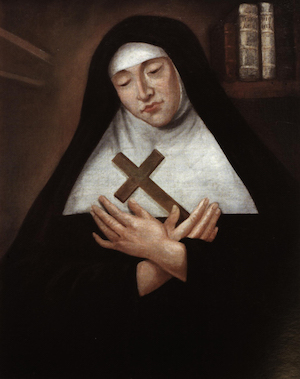
Today we continue our regular series called “Learning from the Saints.” Our guide is expert Bert Ghezzi, a dear friend of mine and the author of numerous books including Voices of the Saints, Saints at Heart, and Discover Christ: Developing a Personal Relationship with Jesus.
His more recent books are The Power of Daily Mass and The Heart of Catholicism. You can learn more about Bert and his work at BertGhezzi.com.
Today, Bert profiles St. Marie of the Incarnation, whose feast we celebrate on April 30.
 Visualize a grandmotherly French woman cuddling an Algonquin child and you have a picture of Mother Marie of the Incarnation, the missionary. Envision the same woman snuggled in God’s lap and you have an image of Mother Marie, the mystic. For like Teresa of Avila, this multi-gifted woman was both a mystic and a missionary.
Visualize a grandmotherly French woman cuddling an Algonquin child and you have a picture of Mother Marie of the Incarnation, the missionary. Envision the same woman snuggled in God’s lap and you have an image of Mother Marie, the mystic. For like Teresa of Avila, this multi-gifted woman was both a mystic and a missionary.
But Marie enjoyed a more diverse worldly experience than Teresa. At 17, she married Claude Martin, a merchant of Tours, France, and bore him a son. Claude died before their third anniversary, but Marie continued to competently manage his business.
All the while, however, God seems to have made gentle assaults on Marie’s soul. In this passage from her Autobiography she told how God startled her with his mercy:
“Suddenly I was stopped in my tracks, both interiorly and exteriorly. In a flash the eyes of my mind were opened and all the faults, sins, imperfections I had ever committed were represented to me both in general and in particular. I saw them with a distinction and clarity more certain than any human effort could produce. At the same moment I saw myself completely immersed in blood. And I was convinced that it was the blood of the son of God and that this precious blood had been shed for my salvation.
“If the goodness of God had not sustained me, I believe I would have died of fright. No human tongue can express how horrible and shocking is the sight of sin, however small it may be. Rather, to see a God of infinite goodness and purity offended by a worm of the earth surpasses horror itself. And especially to see a God-made-man die to expiate sin and shed all his precious blood to appease his Father and in this way to reconcile sinners to him!
“Finally, it is impossible to tell what the soul comprehends during this prodigy. But to see not only the fact of one’s own personal culpability but also the fact that, even if one were the only one guilty of sin, the Son of God would have done for him what he has done for all—this it is that consumes and seems to annihilate the soul.”
The saint swiftly ascended in prayer, so that by age 28 she says she experienced a complete, inexpressible union with God.
In 1629, Marie made the painful decision to leave her son with her sister and joined the Ursulines at Tours. A hunger to save souls and a strange vision of a foreign landscape beckoned her to the Jesuit missions in Canada in 1639. For the next thirty-two years she evangelized and instructed native converts in Quebec. For the work she learned several difficult languages and wrote four catechisms, three for the Algonquins and one for the Iroquois.
During this time she progressed in the course of her mystical union with God, charting it in 1654 in a very readable Autobiography. Claude Martin, her son, became a famous Benedictine priest and honored his mother by writing her life story. Blessed Marie of the Incarnation died in 1672 at age 73.
“Visitors at the mission school could not understand how we could dandle on our laps the little orphans, smeared with grease against the cold and covered only by a small, oily rag. But for us all this was unimaginable joy. Thanks to God’s goodness, our vocation and love for the natives never diminished. I carry them all in my heart and try very gently through my prayers to win them for heaven.”
— St. Marie of the Incarnation
(Image Credit: Our Sunday Visitor)
Read more from Bert at his website www.BertGhezzi.com, or check out his many books on Amazon.

